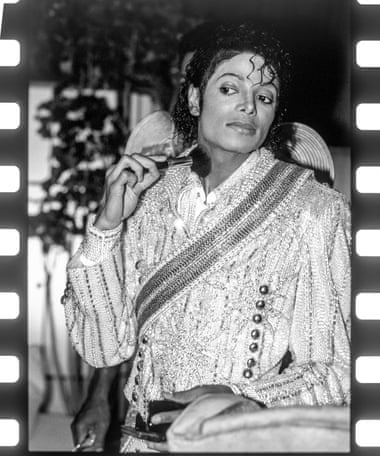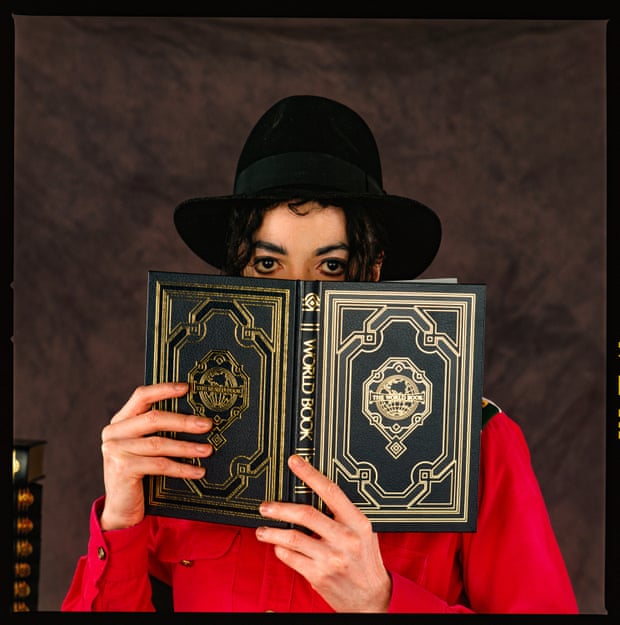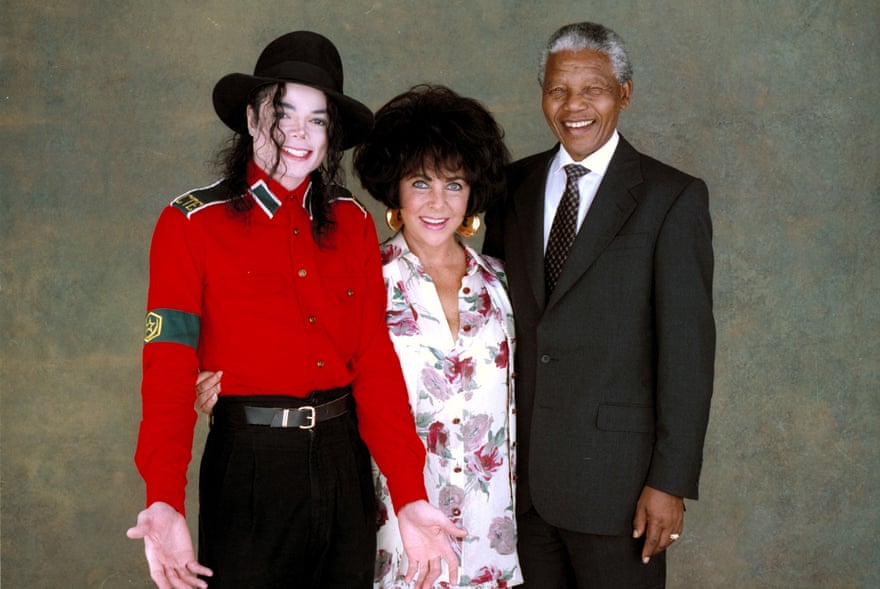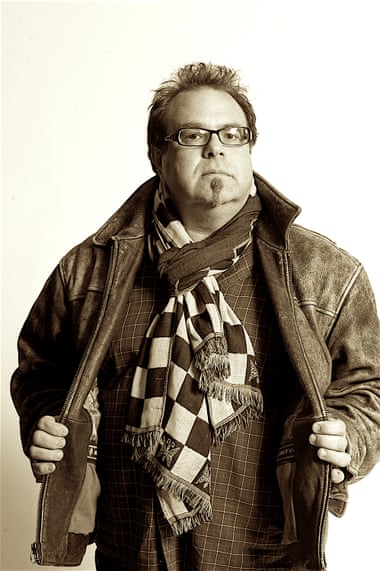Why Did Michael Jackson Dress as a Women
'M e and Michael had our own language," says Harrison Funk. "The buzzword was always the same. He would ask, 'Harrison, can you make magic?' Anything less wasn't acceptable." Funk was the photographer who got closer to Michael Jackson than any other, working with the singer from the late 1970s right up until his death in June 2009, witnessing and capturing his many changes, as the star rose to be the most famous person on the planet.
Funk was born 12 days before Jackson, on 17 August 1958, just outside Brooklyn. He was inspired to pick up a camera by his uncle, Leo Friedman, a famous Broadway photographer. Starting off with street photography and shooting local basketball matches, Funk worked his way up to such magazines as Time, Life and Newsweek. But a chance meeting with Jackson at New York's infamous nightclub Studio 54 (where Jackson, a regular, would dance in the DJ booth to avoid autograph-hunters) set Funk's career on a different trajectory.

Impressed by his versatility, Jackson employed Funk as the official photographer for the Jacksons' Victory tour in 1984. Funk says he quickly sensed the media circus that was starting to form around the singer: "Rupert Murdoch's people called and practically begged me to sneak out a photo of Michael from rehearsals. I told Michael and we laughed about it – but the fact I told him built up a trust."
Subsequently, while on the Victory tour, Funk was given unprecedented access to the singer. One intimate photo taken by Funk captures Jackson applying his own makeup, something he took great pride in. "Him and Jermaine [Jackson] loved putting on their own makeup," says the photographer, who adds that Michael became more and more interested in his appearance, more determined to look sharp, under the influence of such mentors as Gene Kelly, Fred Astaire and James Brown.
Jackson's make-up routine, adds Funk, was also a sign of the singer's gender fluidity: "It wasn't so much femininity on Michael's part as androgyny – he was fluid around gender. Michael had no interest in assigning a gender to anybody." At that moment, he recalls, "he didn't overtly identify as one particular gender". However, when Jackson became a dad, his image changed to that "of father", Funk says. "He became a strong man in that sense."
On the Victory tour, Funk was exposed to occasional outbursts. "Don't be fooled," he says. "Michael had very demanding moments. If he didn't like something, he let you know. Michael was never ridiculing to me ever, but if someone messed up the design of his stage, then he would yell at them. He expected perfection."
The sold-out Victory tour was a turning point for Jackson. Just two years earlier, he released Thriller to stratospheric acclaim, and the media circus was now starting to spiral out of control. Yet some of Funk's most iconic images of Jackson aren't from his undisputed reign in the 1980s, but from the 1990s – when albums Dangerous and HIStory marked the singer's evolution into a more socially conscious artist, who could be both profound (Black and White) and ridiculous (the messiah complex of The Earth Song was so jarring it provoked Jarvis Cocker to storm the stage during the 1996 Brits).
In one of Funk's favourite shots from this period, Jackson can be seen holding his arms out in an almost biblical pose. "People say Michael had a Jesus complex," he says, "but that pisses me off, as it just wasn't true. There was a practical reason for me taking that photo. Michael had huge hands and I wanted to make the most of them as they were expressive – and a good way for him to embrace the world. At that stage, his whole existence was geared towards healing the world, so having big, expressive hands was a very important way to speak to the people." The way he communicated with his hands, adds the photographer, "you'd have thought he was Italian!"
Another Funk photo shows Jackson holding a book in front his face. It is an intensely personal shot intended as an advert for the World Book Encyclopedia, which would be distributed to American classrooms. "The art director gave me carte blanche to do what I wanted, so I really wanted to push the limits of what was possible. Michael's eyes were his most defining feature, way more than his feet. I knew I could capture his soul by focusing on his eyes and that's exactly what happened with that photo."

But was Jackson actually covering his face due to shyness? "Maybe. But his shyness and introversion never hindered his ability to work with me as a photographer. Michael knew exactly what he wanted artistically, right up until probably the last two years of his life, where he got swayed by the wrong people and got in way over his head."
This was the time of the This Is It tour, which Funk had been due to photograph. Jackson was all set to play 50 dates in quick succession at the O2 Arena in London. But, 20 days before the opening night, he died from cardiac arrest, triggered by acute anaesthetics intoxication. "As much as I don't like talking about the end," says Funk, "I will say he got destroyed by people who only had their own financial interests at heart. I can tell you that a big part of his plans following the This Is It tour was to do charity work and use his influence to better mankind."
In 2003, Jackson was charged with child molestation, only to later be acquitted. The memory still angers Funk. "All the accusations and crap he went through," he says. "Let me ask you this: what is a better way to ruin someone who is going to make massive positive changes to the children of the world than to discredit them?"
Jackson's awareness of the power of photography was perhaps best illustrated in the early 1990s, when he asked Funk to shoot him with Elizabeth Taylor and Nelson Mandela, who had recently been released from prison. The image, which Funk describes as the highlight of his career, shows the trio smiling infectiously.

"Mandela was so excited to meet Michael," says Funk. "He flew in all of his family especially. I was told by the publicists I had no time to shoot, but Michael kicked them all out and let me take my time. I didn't want a boring photo so I suggested they jump on each other's backs and hug one another. Liz Taylor said, 'Harrison, you know I've got a bad back!' And Nelson said he was too old and joked he wanted to put his feet up instead. I tried to capture the joy of this incredible moment."
Funk then watched as the three went into a meeting room to discuss plans to topple apartheid, improve women's rights, tackle the Aids crisis, and address crime in Africa. He claims Jackson was acutely aware of how the photo could help Mandela's bid for the South African presidency.
"That image was in something like 400 newspapers. It was real powerful. The next year, Michael went to Africa to shoot the They Don't Care About Us video. He would have done anything for Nelson – Michael and Liz gave his presidential campaign a very generous donation. I believe he and Nelson got on so well as Michael was like the Mandela of music, in the sense that he too broke down a lot of barriers. Remember, Michael was one of the first global black superstars."
But Jackson's image started to change dramatically. Some critics accused the singer of being ashamed of his blackness, and of gaining a dangerous obsession with plastic surgery. In a recent interview, Thriller producer Quincy Jones said: "I used to kill [Michael] about the plastic surgery, man. He'd always justify it and say it was because of some disease he had. Bullshit … He had a problem with his looks because his father told him he was ugly and abused him. What do you expect?"
Funk, however, insists Jackson was actually the victim of a "cruel" media campaign and was suffering from the pigment-destroying skin disease vitiligo (a claim confirmed by Dr Christopher Rogers, who carried out Jackson's autopsy). "It was all a load of bullshit," Funk says of these reports. "He didn't want to look white or find a way out. He was immensely proud to be a black man. Michael was suffering from a cruel skin disease, which changed his appearance, and I had to rise to this as his photographer and adapt his lighting. I think the problem was Michael wanted badly for his skin to look even-toned. I didn't have Photoshop back then so I lit Michael myself and had specific techniques to make him look at his best."

Funk, who seems to have an endless supply of Jackson stories, speaks softly in a New York accent, energetically recalling their nine consecutive rides on Space Mountain at Disneyland. Jackson attempted to persuade Funk to ride it for a 10th time but by then the photographer felt sick and his legs had turned to jelly. They would also regularly take the Viking boat ride at Jackson's Neverland ranch.
"I was sitting across from Michael," says Funk, "shooting him with my camera, as he told the guy controlling the ride to go higher and higher. I screamed at Michael that he'd make me lose my camera. He screamed back, 'I don't want to lose my cookies!" These were in his shirt pocket.
Yet, for all the fun they had together, Funk's most cherished memory of Jackson is a dark one. He remembers sitting with the singer in the home theatre of his Neverland ranch while watching What's Love Got To Do With It, the 1993 biopic about the abusive relationship between Ike and Tina Turner, when Jackson began to cry.
"The scene where Ike beats on Tina was playing and Michael started to tear up. I asked him if he wanted me to stop the film but he signalled to keep it rolling. He squeezed my hand tightly. I really felt his humanity in that moment.
"After the film ended, we walked out of the theatre and Michael asked me to go do bumper cars with him." Funk laughs. "We played pretty nasty and really went for one another. He was like a big kid."
Jackson was not the only star who turned to Funk. The photographer is currently planning a London exhibition of his work, which also includes shots of David Bowie, Tina Turner and Amy Winehouse, though the king of pop will of course dominate. This will be an interesting postscript to On the Wall, the show about to open at the National Portrait Gallery that looks at how Jackson was portrayed in paintings and photography.
Funk, who is based in Los Angeles, is quite happy to let his career be defined by his shots of Jackson. While daydreaming, he sometimes hears the singer's voice, imploring him one more time. "Let's make magic," it says.
- Michael Jackson: On the Wall is at the National Portrait Gallery, London, 28 June to 21 October.
kinrosspressita74.blogspot.com
Source: https://www.theguardian.com/artanddesign/2018/jun/20/michael-jackson-personal-photographer-harrison-funk-mandela